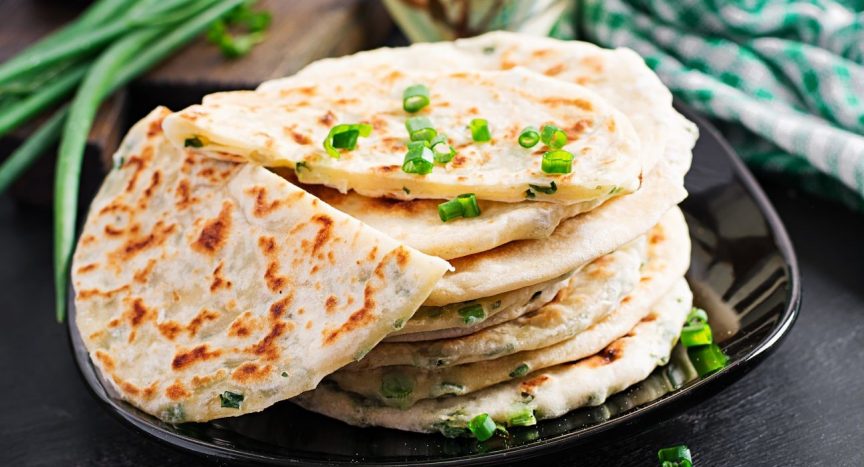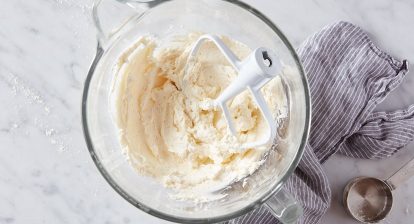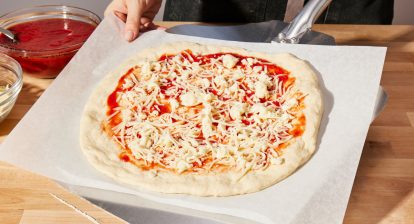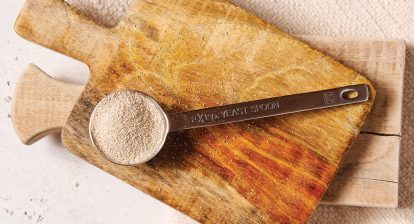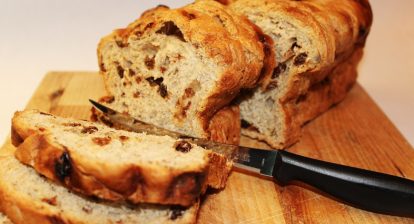Bazlama, a traditional Turkish bread, is a delicious and versatile staple that deserves a place in every home cook's repertoire. Many people struggle with achieving the perfect texture and flavor, often ending up with dry, soft or hard bread. In this article, we will share secret tips on how to prepare Bazlama, ensuring that you create soft, fluffy and mouth-watering Bazlama every time.

Table of Contents
List of ingredients
Get ready to embark on a Bazlama-making adventure with these simple, pantry-friendly ingredients:
- 3 cups all-purpose flour or bread flour
- 1 teaspoon active dry yeast or instant yeast
- 1 1/4 cups warm water
- 1 teaspoon of salt
The power of flour
The star player in this recipe is the flour, and you'll need a generous 3 cups to create the perfect canvas for your Bazlama masterpiece. Whether you choose all-purpose flour or bread flour, this ingredient lays the foundation for a luscious, pillowy loaf.
Maya, the rising star
With just 1 teaspoon of active dry yeast or instant yeast, these little powerhouses will bring your Bazlama to life. They are responsible for creating all those lovely air pockets, making your bread light and fluffy.
Water and Salt, Unsung Heroes
Don't underestimate the importance of the 1 1/4 cups of warm water and 1 teaspoon of salt in this recipe. Water is the glue that holds everything together, while salt enhances all flavors. Together, they are the essential part of the rhythm of your Bazlama group.
To make Bazlama, you will need a large mixing bowl to combine the ingredients and cook the batter. A cast iron skillet, a nonstick skillet, or an electric skillet will work for baking bread. A rolling pin is optional for forming the dough, but you can also use your hands.
Preparation of the dough
Now that you've gathered your ingredients and tools, it's time to dive into the fun part: making the dough! This is where the magic happens and with a few simple steps, you'll be on your way to Bazlama happiness.
Mixing Ingredients
Begin by combining the flour, yeast and salt in your large mixing bowl. Give them a quick beat to make sure they are evenly distributed. Then gradually add the warm water, stirring the mixture with a wooden spoon or with your hands. Continue mixing until a stiff, sticky dough forms. Don't worry if it looks a little messy at this point – that's perfectly normal!
Boiling the dough
Now is the time to get hands on! Sprinkle a little flour on a clean work surface and turn the dough. Start cooking folding the dough on itself, pushing it down and turning it over. You'll want to put some muscle on it, but don't overdo it—think of it as a gentle workout for your butt.
As you cook, the dough will begin to transform. It will become smoother, more elastic and less sticky. If it seems too sticky, add a little more flour; if it is too dry, add a little water. Trust your instincts and adjust as needed. Continue to cook for about 5-10 minutes, until the dough is soft, smooth and springs back when pierced.
Let the dough rest
After all that kneading, your dough deserves a break—and so do you! Form the dough into a ball and place back into the mixing bowl. Cover the bowl with a clean kitchen towel or plastic wrap and let it rest in a warm, draft-free place for about 30 minutes to an hour. This resting time allows the gluten to relax and the flavors to develop.
As the dough rests, you will notice that it begins to rise and increase in size. This is where the yeast does its magic, creating all those lovely air pockets that will make your Bazlama light and fluffy. Once the dough has doubled in size, it is ready for the next step.
Rolling and shaping the dough
Once your dough has had its well-deserved rest and doubled in size, it's time to roll up your sleeves and shape.
Dividing the dough
First, punch the dough to deflate it. This helps redistribute the yeast and release any excess gas bubbles. Then, divide the dough into equal pieces. For accuracy, you can use it or use a kitchen scale. Aim for about 8-10 pieces, depending on how big you want your Bazlama to be.
Forming dough balls
Take each piece of dough and form into a smooth ball. To do this, stick the edges down, creating tension on the surface of the dough. This will help create a tight, smooth top. Place the dough balls on a floured surface, cover them with a clean kitchen towel and let them rest for another 10-15 minutes. This short rest allows the gluten to relax, making the dough easier to make.
Bazlama rotation
Now for the fun part – launch your Bazlama! You can use a pin or your hands for this step. If using a rolling pin, dust it with a little flour to prevent sticking. Take a ball of dough and place it on a floured surface. Begin rolling from the center out, turning the dough as you go to ensure an even thickness. Aim for a round shape, about 1/4 to 1/2 inch thick.
If you prefer a more rustic look, you can skip the dough and use your hands to shape the dough. Flatten the ball of dough with your palms, then use your fingertips to press and roll the dough into a round shape. Don't worry if it's not perfectly circular – that's part of the charm!
Repeat the rolling or hand shaping process with the remaining dough balls. As you finish each one, place them on a floured surface and cover them with a kitchen towel so they don't dry out.
Bazlam cooking
Now that your Bazlama dough is rolled and ready, it's time to bring the heat! Making these delicious loaves is a breeze, and with a few simple tips, you'll be rolling like a pro in no time.
For best results, cook your Bazlama in a hot pan or skillet over medium-high heat. A cast iron pan is ideal, as it retains heat nicely and creates a crispy, golden crust. Before you start cooking, make sure your pan or skillet is nice and hot. You can test the temperature by dropping a few drops of water on the surface – if they sizzle and evaporate quickly, you're good to go!
Bazlama cooking is all about heat management. You want the pan to be hot enough to create a golden, crispy exterior, but not so hot that it burns before the interior is cooked. As you cook, be aware of the heat and adjust as needed.
After placing a wrapped Bazlama in the hot pan, let it cook for about 30 seconds to a minute, until you see bubbles forming on the surface and the bottom is golden brown. Using a spatula, carefully flip the Bazlama and cook the other side for 30 seconds to a minute, until golden brown and cooked through.
Repeat the cooking process with the remaining Bazlama, placing them on a plate as you go.
Tips for the Perfect Flatbread
To ensure your Bazlama turns out perfect every time, keep these expert tips in mind:
Nailing the dough consistency
The key to perfect Bazlama lies in the consistency of the dough. You want a dough that is soft, pliable and slightly sticky. If your dough seems too dry, don't be afraid to add a little more water. Too wet? Dust with a little more flour. Trust your instincts and adjust until you have a dough that's fun to work with.
Mastering the cooking temperature
Cooking temperature is another crucial factor in the success of Bazlama. You want your pan or skillet to be hot enough to create those lovely golden-brown spots, but not so scalding that it burns the outside before it's cooked. Aim for medium-high heat and hold your bread carefully while it cooks. If you find that the Bazlama is browning too quickly, lower the heat a little.
Keeping an eye on moisture
Moisture content is the secret ingredient to soft, cushiony Bazlama. To prevent your bread from drying out as it cooks, keep a clean kitchen towel draped over the cooked Bazlama as you work through the batch. The towel will trap the steam, ensuring that each part remains soft and moist and luscious.
Suggestions for service
Associations for Bazlama
Bazlama is a versatile bread that pairs beautifully with a variety of accompaniments. Try spreading a dollop of creamy, delicious yogurt on top, then sprinkle with fresh herbs like mint or dill for a burst of freshness. For a more indulgent treat, drizzle your Bazlama with extra virgin olive oil and a pinch of sea salt – the perfect combination of richness and simplicity.
Meal ideas with Bazlama
Bazlama is a star player in countless delicious foods. Slice and serve alongside a hearty lentil soup or a colorful Mediterranean salad for a satisfying lunch. Or transform your Bazlama into a pizza-like creation by topping it with cheese, veggies, and your favorite protein, then tossing it under the broiler until the cheese melts and bubbles. The possibilities are endless!
end
This guide has equipped you with the knowledge and confidence to create delicious Bazlama, a traditional Turkish bread. By following our expert advice on batter consistency, cooking temperature and humidity, you'll achieve perfect results every time. Bazlama's versatility makes it a crowd pleaser, whether it's served alongside soup, as a pizza base, or simply with olive oil and salt. Embrace your inner artist and bake with confidence!
How to make Bazlama: FAQ
What does Turkish flat bread consist of?
Turkish flat bread, also known as pide or Bazlama, is usually made from a simple dough consisting of flour, water, salt and yeast. The dough is mixed, left to rise and then shaped into a flat round or oval shape. It is often baked in a hot oven or pan, resulting in a soft, fluffy texture with a slightly crisp exterior.
Is Turkish bread the same as pita bread?
While Turkish bread and pita bread share similarities in appearance and texture, they are not the same. Turkish bread tends to be thicker and softer than pita bread, with a more pronounced flavor due to the use of yogurt or milk in some recipes. Pita bread is usually thinner and has a pocket that forms during baking, making it ideal for filling.
Where does Bazlama bread come from?
Bazlama bread originates from Turkey, especially in rural areas and villages. It is a traditional bread enjoyed for generations. Bread is often made at home or in local bakeries and is a staple of Turkish cuisine. Its simple ingredients and easy preparation make it a popular choice for everyday meals and gatherings.
What is the meaning of Bazlama?
The word “Bazlama” is derived from the Turkish word “bazlamak”, which means “to crush”. This name refers to the way bread is made, where the dough is pressed or flattened by hand before baking. Bazlama is also known as “country bread” or “garden bread” as it is usually made in rural areas using simple and readily available ingredients.

